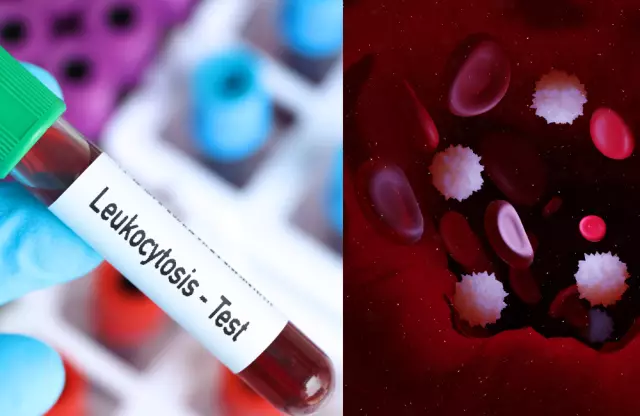- Author Rachel Wainwright [email protected].
- Public 2024-01-15 19:51.
- Last modified 2025-11-02 20:14.
Dyslipidemia
The content of the article:
- Causes
- Types of dyslipidemias
- Signs
- Diagnostics
- Treatment
- Prevention
- Consequences and complications
Dyslipidemia is a disorder of lipid metabolism, which consists in a change in the concentration of lipids in the blood (decrease or increase) and refers to the risk factors for the development of numerous pathological processes in the body.
Cholesterol is an organic compound that, among other things, is found in cell membranes. This substance is insoluble in water, but soluble in fats and organic solvents. Approximately 80% of cholesterol is produced by the body itself (liver, intestines, adrenal glands, kidneys, sex glands participate in its production), the remaining 20% enter the body with food. The intestinal microflora is actively involved in the metabolism of cholesterol.
The functions of cholesterol include ensuring the stability of cell membranes in a wide temperature range, participation in the synthesis of vitamin D, adrenal hormones (including estrogens, progesterone, testosterone, cortisol, aldosterone), and bile acids.
The transport forms of lipids in the body, as well as the structural elements of cell membranes, are lipoproteins, which are complexes consisting of lipids (lipo-) and proteins (proteins). Lipoproteins are subdivided into free (blood plasma lipoproteins, soluble in water) and structural (lipoproteins of cell membranes, myelin sheath of nerve fibers, insoluble in water).
The most studied free lipoproteins are blood plasma lipoproteins, which are classified according to their density (the higher the lipid content, the lower the density):
- very low density lipoproteins;
- low density lipoproteins;
- high density lipoproteins;
- chylomicrons.
Cholesterol is transported to peripheral tissues by chylomicrons, very low and low density lipoproteins; it is transported to the liver by high density lipoproteins. During lipolytic degradation of very low density lipoproteins, which occurs under the action of the enzyme lipoprotein lipase, intermediate density lipoproteins are formed. Normally, intermediate-density lipoproteins are characterized by a short lifetime in the blood, but they are able to accumulate with some lipid metabolism disorders.
Dyslipidemia is one of the main risk factors for the development of atherosclerosis, which, in turn, is responsible for most of the pathologies of the cardiovascular system that occur in old age. Atherogenic disorders of lipid metabolism include:
- increased concentration of total blood cholesterol;
- increased levels of triglycerides and low density lipoproteins;
- lowering high density lipoprotein levels.
Causes
The reasons for the development of dyslipidemias can be congenital (single or multiple mutations that cause overproduction or defects in the release of triglycerides and low density lipoproteins, or hypoproduction or excessive excretion of high density lipoproteins), and acquired. Most often, dyslipidemia is caused by a combination of several factors.
The main diseases that contribute to the development of this pathological process include diffuse liver diseases, chronic renal failure, hypothyroidism. Dyslipidemia often occurs in patients with diabetes mellitus. The reason is the tendency of such patients to atherogenesis in combination with an increased concentration of triglycerides and low density lipoproteins in the blood and a simultaneous decrease in the level of high density lipoproteins. Patients with type 2 diabetes mellitus are at high risk of developing dyslipidemia, especially those with a combination of low diabetes control and severe obesity.
Other risk factors include:
- a family history of dyslipidemia, i.e. a hereditary predisposition;
- arterial hypertension;
- poor nutrition (especially overeating, excessive consumption of fatty foods);
- lack of physical activity;
- overweight (especially abdominal obesity);
- bad habits;
- psycho-emotional stress;
- taking certain medications (diuretics, immunosuppressants, etc.);
- age over 45.

Types of dyslipidemias
Dyslipidemias are divided into congenital and acquired, as well as isolated and combined. Hereditary dyslipidemias are monogenic, homozygous, and heterozygous. Acquired items can be primary, secondary, or alimentary.
According to the Fredrickson classification of dyslipidemias (hyperlipidemias), which is adopted by the World Health Organization as the international standard nomenclature for lipid metabolism disorders, the pathological process is divided into five types:
- dyslipidemia type 1 (hereditary hyperchylomicronemia, primary hyperlipoproteinemia) - characterized by an increase in the level of chylomicrons; does not belong to the main reasons for the development of atherosclerotic lesions; the frequency of occurrence in the general population is 0.1%;
- dyslipidemia type 2a (polygenic hypercholesterolemia, hereditary hypercholesterolemia) - an increase in the level of low-density lipoproteins; frequency of occurrence - 0.4%;
- dyslipidemia type 2b (combined hyperlipidemia) - increased levels of low, very low density lipoproteins and triglycerides; diagnosed in about 10%;
- dyslipidemia type 3 (hereditary dys-beta-lipoproteinemia) - an increase in the level of intermediate density lipoproteins; high likelihood of developing atherosclerotic lesions of the blood vessels; frequency of occurrence - 0.02%;
- dyslipidemia type 4 (endogenous hyperlipemia) - an increase in the level of very low density lipoproteins; occurs in 1%;
- dyslipidemia type 5 (hereditary hypertriglyceridemia) - an increase in the level of chylomicrons and very low density lipoproteins.
WHO classification of hyperlipidemias:
| Phenotype | Plasma HCS | TG | Drug changes | Atherogenicity |
| I | Promoted | Increased or normal | ↑ XM | Non-atherogenic |
| II a | Promoted | Normal | ↑ LDL | High |
| II b | Promoted | Enhanced | ↑ LDL and VLDL | High |
| III | Promoted | Enhanced | ↑ LDPP | High |
| IV | More often normal | Enhanced | ↑ VLDL | Moderate |
| V | Promoted | Enhanced | ↑ XM and VLDLP | Low |
Signs
Dyslipidemia does not have specific manifestations, that is, manifestations characteristic only of it; its symptoms are similar to the symptoms of many other diseases. Patients with dyslipidemia may experience shortness of breath, increased blood pressure, weight gain, and impaired hemostasis.
Clinical markers of dyslipidemia include slowly growing benign formations on the skin - xanthomas, which look like clearly demarcated yellow plaques with a smooth or wrinkled surface. Xanthomas are most often localized on the soles of the feet, knee joints, hands, thighs, buttocks, back, face, scalp, less often on the mucous membranes of the lips, soft and hard palate. Their education is not accompanied by any subjective sensations. When the xanthomas merge, a large plaque with a lobular structure is formed.

Source: nezdorov.com
Sometimes with dyslipidemia, cholesterol deposits appear under the skin of the upper eyelid (xanthelasma), which are painless, yellow neoplasms that slightly rise above the skin. Most often they occur in women. Xanthelasmas can be single or multiple, have a soft texture and, as a rule, are localized on both eyelids. Multiple xanthelasmas are prone to fusion and the formation of tuberous elements, in some cases, the neoplasms merge into a continuous strip with an uneven contour, which runs through the entire upper eyelid. For xanthelasm, as well as for xanthomas, malignant degeneration is not characteristic.
With hereditary dyslipidemia, a lipoid arch of the cornea may appear, which is a layer of lipid deposits on the periphery of the cornea of the eye of white or grayish-white color. As a rule, the lipoid arch of the cornea appears in people over 50, but sometimes it also occurs in younger patients.
Diagnostics
Dyslipidemia is essentially a laboratory indicator that can only be determined by the results of a biochemical blood test.
Family history data, physical examination and a number of additional studies are important to determine the type of dyslipidemia.
A biochemical blood test allows you to determine the content of total cholesterol, low and high density lipoproteins, triglycerides, atherogenic coefficient. To get the correct result of the analysis, blood must be donated in the morning on an empty stomach, the day before, refrain from excessive physical exertion and eating fatty foods.
Additional laboratory tests: general analysis of blood and urine, determination of the level of homocysteine, blood glucose, creatinine, liver enzymes, thyroid-stimulating hormone, homocysteine, genetic research.
From instrumental diagnostic methods, ultrasound examination of blood vessels is used.
Treatment
The main thing in the treatment of dyslipidemia is to eliminate the causes of its development (with secondary dyslipidemia) or contributing factors (with primary).
First of all, a lifestyle modification is needed:
- optimization of the daily routine;
- avoidance of excessive mental stress;
- regular, but not debilitating physical activity;
- dieting.
The diet for dyslipidemia should be followed for a long time, and ideally for life. It is necessary to completely exclude or significantly limit the content of high-cholesterol foods, saturated fatty acids in the diet, reduce the consumption of table salt. It is necessary to limit the consumption of fatty meat and fish, offal, cheese, eggs, butter, fatty sour milk products, coffee. Fractional meals are recommended - eating at least 6 times a day in small portions.
The diet should contain sea fish, lean meat, poultry, fruits, vegetables, dairy products of low fat content, cereals, and wholemeal bread. Dishes are recommended to be steamed, boiled, baked or stewed.

Source: okeydoc.ru
Drug therapy consists in the use of drugs of the statin group, heparins, bile acid sequestrants, inhibitors of cholesterol absorption in the intestine. With high blood pressure, antihypertensive drugs are prescribed.
Medical treatment of dyslipidemia in children is carried out only after 10 years, subject to two conditions:
- no family history of cardiovascular pathology;
- the positive effect of diet therapy.
Herbal medicine can be used as an additional method. Used preparations from plants with lipotropic action (dandelion root, rose hips, birch buds, plantain juice, corn silk, immortelle flowers). It should be borne in mind that such agents are contraindicated for use in patients with concomitant disorders of bile flow through the biliary tract, since they have a choleretic effect.
In some cases, they resort to intravenous laser irradiation of blood in order to free it from unwanted lipid elements.
Xanthomas and xanthelasmas are removed surgically or by methods of electro- or laser coagulation, cryodestruction, radio wave method. Small neoplasms are often removed by diathermocoagulation. Removal of such neoplasms is performed on an outpatient basis using local anesthesia.
Prevention
In order to prevent the development of dyslipidemia, it is recommended:
- balanced diet;
- correction of excess weight;
- rejection of bad habits;
- sufficient physical activity;
- avoidance of excessive mental stress;
- blood pressure control;
- adequate work and rest regime;
- treatment of diseases that can lead to a disorder of lipid metabolism.
Consequences and complications
In the absence of treatment, against the background of dyslipidemia, vascular atherosclerosis develops, which results in: ischemic heart disease, myocardial infarction, heart rhythm disturbances, heart failure, ischemic stroke, hypertension, intestinal infarction, intermittent claudication, trophic ulcers.
YouTube video related to the article:

Anna Aksenova Medical journalist About the author
Education: 2004-2007 "First Kiev Medical College" specialty "Laboratory Diagnostics".
The information is generalized and provided for informational purposes only. At the first sign of illness, see your doctor. Self-medication is hazardous to health!






